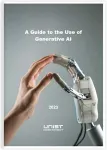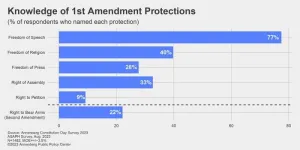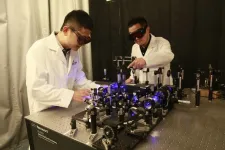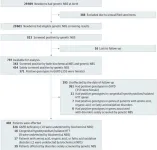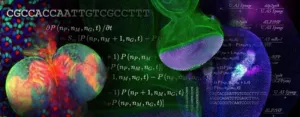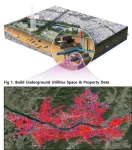(Press-News.org) Areas in Vancouver with the greatest need for restorative nature often have the least exposure to it, according to a new UBC study published recently in Ambio. These neighbourhoods include Strathcona, downtown Vancouver, the West End, southern Sunset and Marpole.
The researchers developed a new tool, the local restorative nature (LRN) index to assess spaces for the presence of qualities that promote mental well-being. While initially applied in Vancouver, the index can also be used in any urban landscape, according to lead author Dr. Tahia Devisscher, an assistant professor in the faculty of forestry.
We sat down with Dr. Devisscher to discuss the study findings and their implications for urban greening and mental health.
What led you to create the local restorative nature index? How does it work?
The LRN index is a new tool that is specifically designed to assess the healing qualities of green space. Research tells us that green spaces have many qualities that can promote mental well-being, but we don’t have a systematic, location-specific method for assessing these qualities. We formulated the LRN index to enable us to do that.
The index assigns a score based on perceived sensory dimensions deemed important for mental health: “refuge,” “wild nature” and “diversity.” We developed proxy indicators for these dimensions based on tree and shrub biomass and density, green canopy coverage, water features and the diversity of tree species and vegetation types present in any given area. These factors are associated with positive feelings and an easing of stress; they facilitate inward-directed, even “passive” activities that are restorative, such as strolling in the park or quietly contemplating nature. The higher a space scores across these dimensions, the more revitalizing it proves to be.
What did you discover when you applied the index in Vancouver?
Using the dissemination area—a census term representing approximately 250 households—as our unit of analysis, we observed that restorative green spaces are distributed unevenly across Vancouver. Neighbourhoods like Shaughnessy, Dunbar Southlands and West Point Grey featured many dissemination areas with high LRN scores. Areas like downtown Vancouver and Strathcona had fewer dissemination areas with high LRN scores. As well, ethnically homogenous dissemination areas tended to display higher LRN scores.
More importantly, we found that areas with the greatest need for restorative nature often have the least exposure to it. When we compared LRN scores in different neighbourhoods with their socioeconomic vulnerability, we noticed that more vulnerable neighbourhoods typically had lower LRN scores.
Hotspots marked by both higher vulnerability scores and low LRN scores included Strathcona, Downtown, West End, southern Sunset and Marpole. Urban planners may want to pay special attention to these neighbourhoods when developing greening aimed at improving mental well-being.
For our study, socioeconomic vulnerability was assessed by combining census data, including housing types, employment rates and cultural diversity. Neighbourhoods with a higher proportion of rental housing, lower employment rates, or greater ethnocultural diversity tended to receive higher vulnerability scores.
What other trends did you observe?
We found a distinct gradient running from west to east in the city. In the northwest areas of the city, where homeownership was more prevalent, there was also greater availability of restorative natural spaces. In the southeastern neighbourhoods, where rental buildings predominated, there was less availability of restorative green space.
One surprise was that there were areas with higher unemployment rates or lower financial resources that had more exposure to green spaces, and vice versa. This is a puzzle we aim to explore further in future studies.
What implications do your findings have for other expanding cities?
Vancouver was the focus of our study, but the LRN index can be adapted to any other urban landscape – to uncover disparities in the distribution of restorative nature and assist urban planners in prioritizing areas that require immediate attention. Planners worldwide can use it to tailor their strategies to their city’s unique needs.
We also encourage other scholars to consider expanding the LRN index, perhaps by incorporating additional dimensions of mental restoration, such as serenity (linked to low noise levels) and viewshed (access to natural vistas). Future research can also investigate how people access and experience restorative nature.
Dr. Devisscher and co-author Dr. Ingrid Jarvis are available for interviews.
Interview language(s): English (Devisscher, Jarvis), Spanish (Devisscher)
Multimedia assets
Maps and researcher head shot (Dropbox) END
New tool can reveal inequitable distribution of ‘healing’ green spaces
Restorative nature index developed at UBC assess spaces for qualities that promote mental well-being
2023-09-14
ELSE PRESS RELEASES FROM THIS DATE:
Many don’t know key facts about US Constitution, Annenberg study finds
2023-09-14
PHILADELPHIA – Many Americans do not know what rights are protected under the First Amendment and a substantial number cannot name all three branches of government, according to the 2023 Annenberg Constitution Day Civics Survey.
The Annenberg Public Policy Center’s annual, nationally representative survey finds that when U.S. adults are asked to name the specific rights guaranteed by the First Amendment to the Constitution, only one right is recalled by most of the respondents: Freedom of speech, ...
All work and no play will really make a dull life - new research reveals
2023-09-14
The study across three countries led by the Department of Psychology’s Dr Paul Hanel discovered people who prioritised achievement over enjoyment were less happy on the next day.
Whereas those who aimed for freedom said they had a 13% increase in well-being, recording better sleep quality and life satisfaction.
And participants who tried to relax and follow their hobbies recorded an average well-being boost of 8% and a 10% drop in stress and anxiety.
Dr Hanel worked with colleagues at the University of Bath on the Journal of Personality-published study.
For the first ...
New poll shows 77% of Massachusetts residents support $600 child & family tax credit
2023-09-14
Boston, MA – New polling data released late last week shows 77% of surveyed Massachusetts residents support a $600 state Child and Family Tax Credit. This polling confirms the popularity of the more generous Child and Family Tax Credit included in the House tax package, which is under consideration alongside the Senate tax bill by a bicameral conference committee.
“The overwhelming support for a $600 tax credit per child matches up with the stories I have heard from families across my district, and the experiences of working Massachusetts families that they need more financial ...
New camera offers ultrafast imaging at a fraction of the normal cost
2023-09-14
WASHINGTON — Capturing blur-free images of fast movements like falling water droplets or molecular interactions requires expensive ultrafast cameras that acquire millions of images per second. In a new paper, researchers report a camera that could offer a much less expensive way to achieve ultrafast imaging for a wide range of applications such as real-time monitoring of drug delivery or high-speed lidar systems for autonomous driving.
“Our camera uses a completely new method to achieve high-speed imaging,” said Jinyang Liang from the Institut national de la recherche scientifique (INRS) ...
Peer-led patient navigation helps minoritized patients engage in their own mental healthcare
2023-09-14
INDIANAPOLIS – Research scientists led by Johanne Eliacin, PhD, of the U.S. Department of Veterans’ Affairs (VA) and Regenstrief Institute, have developed PARTNER-MH, an innovative, peer-led patient navigation program to support racially and ethnically minoritized veterans seeking mental healthcare, regardless of the types of mental health services needed or their mental health diagnoses.
In two peer-reviewed published papers they report significant improvements in mental health outcomes and high participant satisfaction with the program.
PARTNER-MH, developed for VA mental ...
Enhancing neonatal health: Genomic sequencing as a primary screening tool
2023-09-14
Newborn screening (NBS) is routinely performed across the world using biochemical testing methods. Recent advancements in genetic sequencing are a potential game-changer for newborn screening, swiftly assessing a comprehensive range of monogenic disorders. Yet, the effectiveness of genetic sequencing as an alternative method for NBS has not previously been studied.
To evaluate the outcomes of applying gene panel sequencing as a first-tier newborn screening test, a recent study conducted by eight NBS centers and BGI Genomics was ...
Take the money now or later? Financial scarcity doesn’t lead to poor decision making
2023-09-14
When people feel that their resources are scarce – that they don’t have enough money or time to meet their needs – they often make decisions that favor short-term gains over long-term benefits. Because of that, researchers have argued that scarcity pushes people to make myopic, impulsive decisions. But a study published by the American Psychological Association provides support for a different, less widely held view: People experiencing scarcity make reasonable decisions based on their circumstances, and only ...
Researchers make strides in harnessing low-grade heat for efficient energy conversion
2023-09-14
A team of researchers, jointly led by Professor Hyun-Wook Lee and Professor Dong-Hwa Seo from the School of Energy and Chemical Engineering at the Ulsan National Institute of Science and Technology (UNIST), in collaboration with Professor Seok Woo Lee from Nanyang Technological University in Singapore, has achieved significant breakthroughs in harnessing low-grade heat sources (<100 °C) for efficient energy conversion. Their groundbreaking work focuses on developing a highly efficient Thermally Regenerative Electrochemical Cycle (TREC) system capable of converting small temperature differences into usable energy.
Conventional energy-harvesting ...
New $50 million institute aims to use the power of math to model, predict biological processes
2023-09-14
Building a mathematics-based understanding of biology at all scales of life — from individual cells to interactions between species — is the goal of a new $50 million institute supported by the U.S. National Science Foundation in partnership with the Simons Foundation. The two organizations are each providing $25 million to launch the National Institute for Theory and Mathematics in Biology (NITMB). The institute will bring together experts across the mathematical and biological sciences to explore research challenges related to a broad range of topics and industries, such as the environment, biomedicine and biotechnology.
The institute will be led by Northwestern University ...
Preventing ground collapse through new AI-based monitoring
2023-09-14
As severe urban overcrowding is trending worldwide many underground development projects are being carried out in metropolitan centers worldwide. South Korea has experienced problems such as aging underground facilities and inaccurate information management due to rapid urban development since the 1970s and 1980s. Accident prevention has become a major challenge since accidents in underground spaces have occurred due to various causes.
The Korean government is undertaking projects to digitize underground facilities and ground information and establish a 3D underground space information database to prevent ...
LAST 30 PRESS RELEASES:
Air pollution exposure and birth weight
Obstructive sleep apnea risk and mental health conditions among older adults
How talking slows eye movements behind the wheel
The Ceramic Society of Japan’s Oxoate Ceramics Research Association launches new international book project
Heart-brain connection: international study reveals the role of the vagus nerve in keeping the heart young
Researchers identify Rb1 as a predictive biomarker for a new therapeutic strategy in some breast cancers
Survey reveals ethical gaps slowing AI adoption in pediatric surgery
Stimulant ADHD medications work differently than thought
AI overestimates how smart people are, according to HSE economists
HSE researchers create genome-wide map of quadruplexes
Scientists boost cell "powerhouses" to burn more calories
Automatic label checking: The missing step in making reliable medical AI
Low daily alcohol intake linked to 50% heightened mouth cancer risk in India
American Meteorological Society announces Rick Spinrad as 2026 President-Elect
Biomass-based carbon capture spotlighted in newly released global climate webinar recording
Illuminating invisible nano pollutants: advanced bioimaging tracks the full journey of emerging nanoscale contaminants in living systems
How does age affect recovery from spinal cord injury?
Novel AI tool offers prognosis for patients with head and neck cancer
Fathers’ microplastic exposure tied to their children’s metabolic problems
Research validates laboratory model for studying high-grade serous ovarian cancer
SIR 2026 delivers transformative breakthroughs in minimally invasive medicine to improve patient care
Stem Cell Reports most downloaded papers of 2025 highlight the breadth and impact of stem cell research
Oxford-led study estimates NHS spends around 3% of its primary and secondary care budget on the health impacts of heat and cold in England
A researcher’s long quest leads to a smart composite breakthrough
Urban wild bees act as “microbial sensors” of city health.
New study finds where you live affects recovery after a hip fracture
Forecasting the impact of fully automated vehicle adoption on US road traffic injuries
Alcohol-related hospitalizations from 2016 to 2022
Semaglutide and hospitalizations in patients with obesity and established cardiovascular disease
Researchers ‘listen in’ to embryo-mother interactions during implantation using a culture system replicating the womb lining
[Press-News.org] New tool can reveal inequitable distribution of ‘healing’ green spacesRestorative nature index developed at UBC assess spaces for qualities that promote mental well-being

